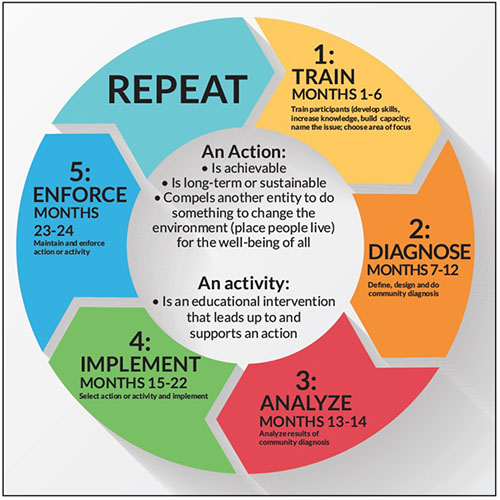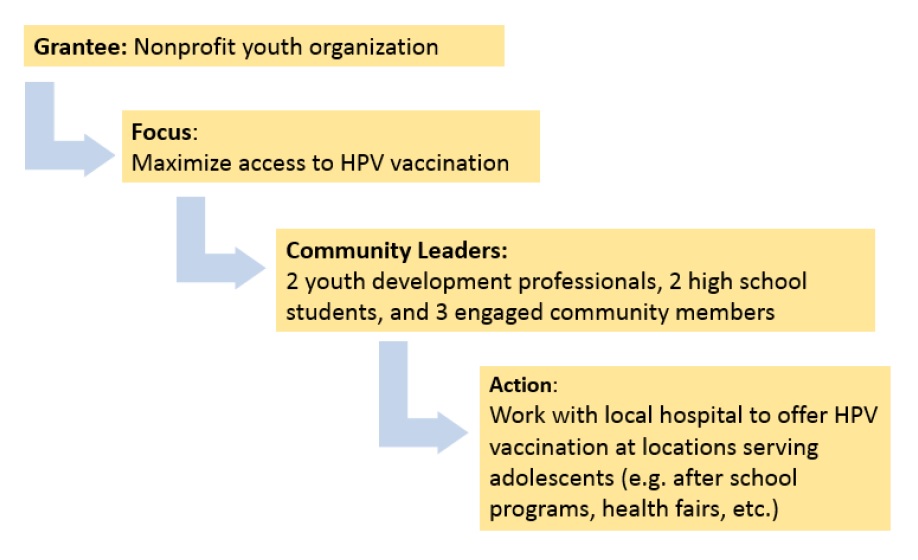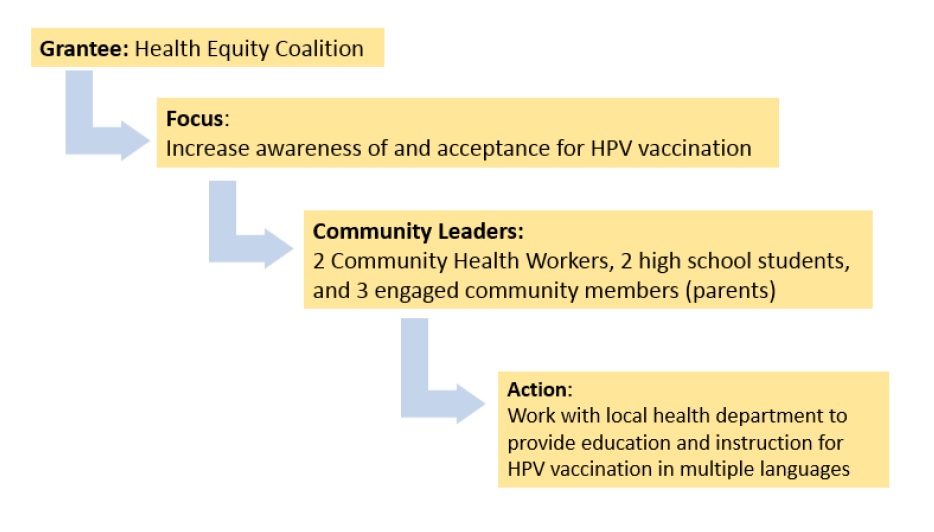Community Action Model
Building community capacity to improve public health
Not currently accepting applications for this type of grant. When funding opportunities are open, the How to Apply page will have current information.
The Community Action Model (CAM) was originally developed in 1996 by the San Francisco Tobacco Free project to address tobacco-related health disparities. The CAM builds community capacity through a five-step process resulting in policy, systems and/or environmental changes that can ultimately have a larger impact on improving public health than a single project and/or organization may be able to. CAM is based on the principle that efforts to improve public health must consider both wellness and the potential social inequities that may create a barrier toward achieving wellness in the context of the systems and environments that people live in.
Solutions to address health inequities, including those in cancer prevention and control, must involve leadership from communities that are most impacted. Thus, cancer control efforts must expand its focus beyond individual behaviors to mobilizing community members and agencies to improve conditions that reduce the burden of cancer through community-engaged systems change.
The Community Partnership Program will fund four organizations to implement the Community Action Model (CAM) to address a pressing cancer-related need. Specific topic areas may change per funding cycle based on need and priority identified by the Knight Cancer Institute.
Details and requirements
CAM grants will consist of a $50,000 award annually for up to two years (maximum $100,000 over two years) for organizations to implement all five steps of the Community Action Model from August 1, 2019 to July 31, 2021. Specifically, funded organizations will:
- Designate at minimum a single 0.6 FTE Project Coordinator(s)
- Train and provide stipends and support to 6-8 Community Leaders who will implement all five Community Action Model steps to address the selected HPV vaccination focus area.
- Engage and implement educational activities to stakeholders that move toward a policy, systems and/or environmental change that is both impactful and sustainable through an Action phase.
It is anticipated that organizations will be funded for two years, however all awarded organizations are required to demonstrate successful completion of first year deliverables in order to be considered for a second year of funding. Eligible projects will be required to submit a year 2 work plan and budget (up to $50,000) to implement steps 3-5 in support of the selected action.
5-step process
The Community Action Model (CAM) is a 5-step process that builds the capacity of community leaders to address specific cancer-related topics through policy, systems and/or environmental change. The Community Action Model has two goals:
- For community members to understand and influence the policies, systems, and environments that affect their lives with a goal to advance health equity (e.g. improving vaccination delivery systems rather than focusing on individual behavior change).
- To build the capacity of communities to create sustainable changes to improve the cancer-related health and well-being of their communities.
Each step of the Community Action Model process is detailed below:

Step 1: Recruit and train community leaders (months 1-6)
- Grantee/Project Coordinator serves as project lead and participates in orientation
- Project Coordinator recruits a team of community leaders who are:
- Individuals who represent the population(s) most affected by the selected HPV vaccination focus area.
- Either adults or youth who are fully committed to the five step process,including orientation, meetings and implementation of an action or activity.
- Committed to 1-2 years to participate in the full CAM process.
- Project Coordinator assesses the skills of community leaders to determine training and support needs
- Project Coordinator develops and implements curricula and workshops throughout the first year
Step 2: Community diagnosis (months 7-12)
- Project Coordinators will receive ongoing training and technical assistance from Community Partnership Program
- Project Coordinators will support community leaders in developing a Community Diagnosis Plan that will outline their research questions and methodology to gain a deeper understanding of the local implications of the selected focus area.
- Each team will implement their Community Diagnosis Plan (data collection)
Step 3: Diagnosis analysis and present findings (months 13-14)
- Project Coordinators train community leaders to analyze the findings of their research/diagnosis, develop key findings and identify potential policy, systems and/or environmental change strategies to be implemented.
- Project Coordinators compile a report outlining their conclusions and strategy/action recommendations.
- Grantees participate in CAM Showcase to present their findings to peers, the CPP team and stakeholders.
- Project teams are required to deliver a presentation on their findings back to community members.
Step 4: Action plan (months 15-22)
- Community Leaders select one "action" or activity to address the defined issue.
- Project teams develop and implement an action plan to implement a pilot or demonstration project that shows feasibility and effectiveness of the chosen action/activity.
Step 5: Maintain and enforce the action (months 23-24)
- Once implemented, project teams work to ensure the action is maintained and enforced by developing and implementing a sustainability plan.
- Funded agencies are required to complete a final report and participate in other close-out activities related to the grant.
Topic for 2019-1: HPV vaccination
In fall of 2018, the President's Cancer Panel urged stakeholders worldwide to renew their commitment to prioritize HPV vaccination for cancer prevention. Human papillomaviruses (HPV) can cause six types of cancer—cervical, oropharyngeal, anal, penile, vulvar, and vaginal—and several other diseases. Over 90% of HPV cancers are preventable through HPV vaccination. Nationally, HPV vaccination coverage lags behind vaccinations for other conditions and remains far below the Healthy People 2020 target of 80% coverage by 2020.
In alignment with current national and statewide efforts to increase HPV vaccination rates, applicants selected one of two focus areas:
Focus area 1: Maximize access to HPV vaccination
Goal 1: Ensuring that HPV vaccination is affordable and convenient to support optimal vaccine uptake.
Focus area 2: Increase awareness of and acceptance for HPV vaccination
Goal 2: Delivery of clear, accurate information about HPV vaccination, its cancer prevention benefits to address misinformation and support optimal vaccine uptake.
Focus area 1: Maximize access to HPV vaccination
Goal 1: Ensuring that HPV vaccination is affordable and convenient to support optimal vaccine uptake.
Ensuring that HPV vaccination is affordable and convenient for all U.S. adolescents will support optimal vaccine uptake. Access barriers likely play a role in low and uneven HPV vaccine uptake in the United States. These barriers—and approaches for addressing them—may differ across geographic regions, populations, and clinical settings. National, regional, and local efforts are needed to understand and address existing and potential barriers to access. Two recommended strategies include:
- Maintaining coverage for HPV vaccination costs
- Utilizing alternative settings to expand access to HPV vaccination
Focus area 2: Increase awareness of and acceptance for HPV vaccination
Goal 2: Delivery of clear, accurate information about HPV vaccination, its cancer prevention benefits to address misinformation and support optimal vaccine uptake.
More must be done to increase acceptance of the HPV vaccine. A 2015 survey found that about half of parents of unvaccinated teens did not intend to have their children vaccinated against HPV1. No single reason predominated, but common reasons cited by parents included:
- Vaccination not needed
- Vaccination not recommended by healthcare provider
- Lack of knowledge about the vaccine or diseases caused by HPV
- Concerns about safety and side effects
- Son or daughter not sexually active
Focus area 1: Maximize access to HPV vaccination

Step 1 – Train (months 1-6)
Grantee: Nonprofit youth organization
Action items:
- Project Coordinator identified
- 7 Community Leaders recruited
- 2 youth development professionals
- 2 high school students
- 3 engaged community members
- Project Coordinator and Community Leaders receive training from CPP
- Project Coordinator coordinates additional training for Community Leaders
- Scope of focus area further narrowed: lack of access to HPV vaccination availability outside of regular business hours/clinic setting
Step 2 – Diagnose (months 7-12)
Focus of assessment: local barriers to HPV vaccination, emphasis on barriers to access and ideal times/locations for families' schedules to receive the vaccination
Action items:
- Project Coordinator provides training to Community Leaders on how to conduct Community Diagnosis (data collection)
- Data collection methods selected:
- Primary data: focus groups with parents of youth ages 11-14;key informant interviews with local healthcare providers
- Secondary data: literature review of common barriers to accessing HPV vaccination and review of local vaccination rates by age, socioeconomic status, race, ethnicity, gender, etc.
- Turn in mid-project report, including year 2 work plan and budget
Step 3 – Analyze (months 13-14)
Action items:
- Project Coordinator trains Community Leaders to analyze findings of the Community Diagnosis
- Project Coordinator creates report outlining:
- Conclusions: lower HPV vaccination rates among adolescents with lower SES; lack of clinic appointments available outside of standard workday hours; preference for HPV vaccination availability in evenings/weekends and at non-clinic locations
- Strategy recommendations: increase access to HPV vaccination by bringing mobile healthcare van to locations/events serving adolescents
- Project Coordinator and Community Leaders present their findings at their nonprofit board meeting and a local Community Advisory Council meeting
Step 4 – Implement (months 15-22)
Action items:
- Community Leaders select and implement at least one action based on Community Diagnosis findings:
- Partner with local hospital to bring local mobile healthcare van to locations/events serving adolescents (e.g. after school programs, sports physical/health fairs, etc.)
- Lead a local media campaign promoting the dates/times/locations that the mobile van will be offering the HPV vaccine
Step 5 – Enforce (months 23-24)
Action items:
- Project Coordinator works with Community Leaders to develop a sustainability plan with the local hospital to continue delivering HPV vaccination using mobile healthcare van
- Project Coordinator completes and turns in final project report
Download the CAM focus area examples
Focus area 2: Increase awareness of and acceptance for HPV vaccination

Step 1 – Train (months 1-6)
Grantee: Health Equity Coalition
Action items:
- Project Coordinator identified
- 6 Community Leaders recruited
- 2 Community Health Workers
- 2 high school students
- 2 engaged community members (parents)
- Project Coordinator and Community Leaders receive training from CPP
- Project Coordinator coordinates additional training for Community Leaders
- Scope of focus area further narrowed: cultural barriers to HPV vaccination
Step 2 – Diagnose (months 7-12)
Focus of assessment: local barriers to HPV vaccination, emphasis on cultural barriers
Action items:
- Project Coordinator provides training to Community Leaders on how to conduct Community Diagnosis (data collection)
- Data collection methods selected:
- Primary data: survey and focus groups with parents of youth ages 11-14 (English and Spanish)
- Secondary data: literature review of common barriers to HPV vaccination and review of local vaccination rates by age, race, ethnicity, gender, etc.
- Turn in mid-project report, including year 2 work plan and budget
Step 3 – Analyze (months 13-14)
Action items:
- Project Coordinator trains Community Leaders to analyze findings of the Community Diagnosis
- Project Coordinator creates report outlining:
- Conclusions: lower HPV vaccination rates among Hispanic/Latino adolescents than other races/ethnicities and reported lack of information/education available in Spanish
- Strategy recommendations: partner with local agencies to offer HPV vaccination education in Spanish
- Project Coordinator and Community Leaders present their findings at a local Health Equity Coalition meeting
Step 4 – Implement (months 15-22)
Action items:
- Community Leaders select and implement at least one action based on Community Diagnosis findings:
- Work with local health department to provide education and instruction for HPV vaccination in multiple languages
- Lead a social media campaign to promote HPV vaccination in multiple languages
Step 5 – Enforce (months 23-24)
Action items:
- Community Leaders continue social media campaign
- Project Coordinator works with Community Leaders to develop a sustainability plan to ensure education and information continue to be available locally in multiple languages
- Project Coordinator completes and turns in final project report
Download the 2019-1 CAM focus area examples